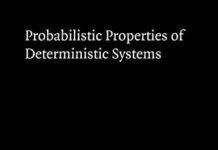
Ebook Info
- Published: 1993
- Number of pages: 488 pages
- Format: PDF
- File Size: 14.52 MB
- Authors: Andrzej Lasota
Description
The first edition of this book was originally published in 1985 under the ti tle “Probabilistic Properties of Deterministic Systems. ” In the intervening years, interest in so-called “chaotic” systems has continued unabated but with a more thoughtful and sober eye toward applications, as befits a ma turing field. This interest in the serious usage of the concepts and techniques of nonlinear dynamics by applied scientists has probably been spurred more by the availability of inexpensive computers than by any other factor. Thus, computer experiments have been prominent, suggesting the wealth of phe nomena that may be resident in nonlinear systems. In particular, they allow one to observe the interdependence between the deterministic and probabilistic properties of these systems such as the existence of invariant measures and densities, statistical stability and periodicity, the influence of stochastic perturbations, the formation of attractors, and many others. The aim of the book, and especially of this second edition, is to present recent theoretical methods which allow one to study these effects. We have taken the opportunity in this second edition to not only correct the errors of the first edition, but also to add substantially new material in five sections and a new chapter.
User’s Reviews
Editorial Reviews: Review “This is a truly outstanding book. It is so well and carefully written that, despite the complexity of the subject matte and the difficulty of some of the mathematics, virtually everything is completely clear on a first reading. Indeed, the book is much more absorbing than most novels.” Probability in the Engineering + Informational Sciences From the Back Cover In recent years there has been an explosive growth in the study of physical, biological, and economic systems that can be profitably studied using densities. Because of the general inaccessibility of the mathematical literature to the nonspecialist, little diffusion of the applicable mathematics into the study of these “chaotic” systems has taken place. This book will help bridge that gap. To show how densities arise in simple deterministic systems, the authors give a unified treatment of a variety of mathematical systems generating densities, ranging from one-dimensional discrete time transformations through continuous time systems described by integro-partial-differential equations. Examples have been drawn from many fields to illustrate the utility of the concepts and techniques presented, and the ideas in this book should thus prove useful in the study of a number of applied sciences. The authors assume that the reader has a knowledge of advanced calculus and differential equations. Basic concepts from measure theory, ergodic theory, the geometry of manifolds, partial differential equations, probability theory and Markov processes, and stochastic integrals and differential equations are introduced as needed. Physicists, chemists, and biomathematicians studying chaotic behavior will find this book of value. It will also be a useful reference or text for mathematicians and graduate students working in ergodic theory and dynamical systems.
Reviews from Amazon users which were colected at the time this book was published on the website:
⭐The book covers exactly what the title promises.Essentially, it is about the evolution of densities by dynamic systems, both deterministic and stochastic.The mathematical prerequisites are not very high, some prior knowledge of measure theory and probability theory is helpful – but not necessary.Concepts not generally known are explained where needed, e.g. Lebeques integration, Itô integrals, etc.The proofs are generally easy to follow, yet rigorous, and the many examples lend intuiton to the subject matter.There are excercises at the end of each chapter – which I cannot comment on, as I did not do them.The only two minus points are the follwing:- Each object (theorem, proposition, equation, example, etc..) gets it own sequence on enumeration. This makes it more difficult to quickly find a reference as theorem 8.4.1 may be many pages AFTER equation 8.4.17.- It has a fair number of typos, most -but not all!- harmless. This is all the more amazing as I read the second edition.These “minuses” do not detract from the value of the book – it is REALLY good!
⭐This is one of my favorite maths books. My interest in it is not so much for the discussion of chaotic systems, but more for that on stochastically perturbed systems. As far as this topic goes, this is the best book I’ve found in the field by far. The treatment is careful and self-contained, and the proofs are clear throughout. Lots of intuition is given with each result.As a caveat, note that the approach is based on analysis in general and functional analysis in particular. If you prefer probabilistic arguments look somewhere else.
⭐
Keywords
Free Download Chaos, Fractals, and Noise: Stochastic Aspects of Dynamics (Applied Mathematical Sciences, 97) 2nd Edition in PDF format
Chaos, Fractals, and Noise: Stochastic Aspects of Dynamics (Applied Mathematical Sciences, 97) 2nd Edition PDF Free Download
Download Chaos, Fractals, and Noise: Stochastic Aspects of Dynamics (Applied Mathematical Sciences, 97) 2nd Edition 1993 PDF Free
Chaos, Fractals, and Noise: Stochastic Aspects of Dynamics (Applied Mathematical Sciences, 97) 2nd Edition 1993 PDF Free Download
Download Chaos, Fractals, and Noise: Stochastic Aspects of Dynamics (Applied Mathematical Sciences, 97) 2nd Edition PDF
Free Download Ebook Chaos, Fractals, and Noise: Stochastic Aspects of Dynamics (Applied Mathematical Sciences, 97) 2nd Edition
